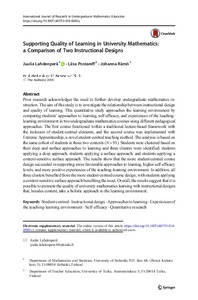Supporting Quality of Learning in University Mathematics: a Comparison of Two Instructional Designs
Rämö Johanna; Postareff Liisa; Lahdenperä Juulia
https://urn.fi/URN:NBN:fi-fe2021042826617
Tiivistelmä
Prior research acknowledges the need to further develop undergraduate mathematics instruction. The aim of this study is to investigate the relationship between instructional design and quality of learning. This quantitative study approaches the learning environment by comparing students’ approaches to learning, self-efficacy, and experiences of the teaching-learning environment in two undergraduate mathematics courses using different pedagogical approaches. The first course functioned within a traditional lecture-based framework with the inclusion of student-centred elements, and the second course was implemented with Extreme Apprenticeship, a novel student-centred teaching method. The analysis is based on the same cohort of students in these two contexts (N = 91). Students were clustered based on their deep and surface approaches to learning and three clusters were identified: students applying a deep approach, students applying a surface approach, and students applying a context-sensitive surface approach. The results show that the more student-centred course design succeeded in supporting more favourable approaches to learning, higher self-efficacy levels, and more positive experiences of the teaching-learning environment. In addition, all three clusters benefited from the more student-centred course design, with students applying a context-sensitive surface approach benefiting the most. Overall, the results suggest that it is possible to promote the quality of university mathematics learning with instructional designs that, besides content, take a holistic approach to the learning environment.
Kokoelmat
- Rinnakkaistallenteet [19207]
